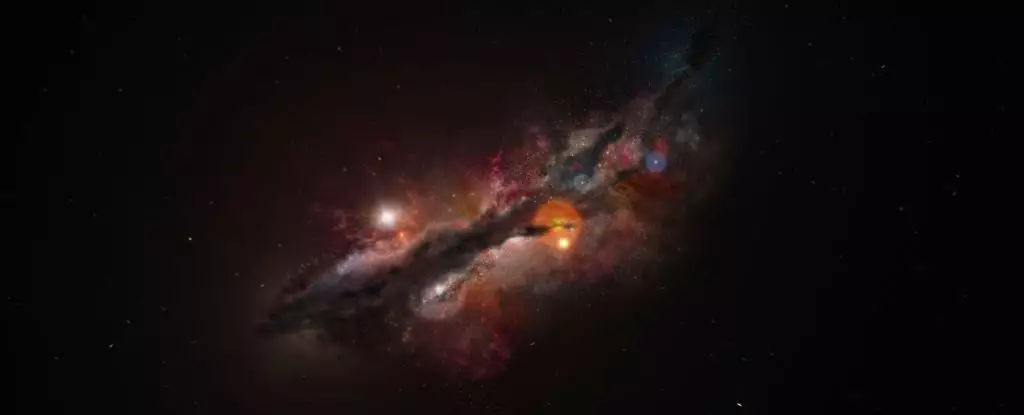In a stunning turn of events, astronomers have encountered a paradox in the form of a galaxy shining brightly in the Cosmic Dawn, merely 300 million years after the Big Bang. Designated JADES-GS-z14-0, this galaxy has emerged with an unexpected abundance of oxygen, a revelation that flips conventional wisdom on its head and challenges long-held assumptions about the timeline of cosmic evolution. Traditionally, scientists believed that heavier elements such as oxygen wouldn’t have materialized in significant quantities for several hundred million years following the universe’s inception. Yet, this discovery hints at a universe that matured at a far more rapid pace than previously envisioned.
Sander Schouws, a cosmologist from Leiden Observatory, eloquently encapsulates the essence of this finding: “It is like finding an adolescent where you would only expect babies.” This analogy effectively communicates the sense of surprise and wonder that accompanies the revelation of this galaxy’s rapid formation and early maturation. It suggests a need for an overhaul of our understanding of galaxy formation, raising intriguing questions about the mechanics of cosmic evolution during the universe’s infancy.
Charting New Territory in Cosmology
The very existence of JADES-GS-z14-0 poses significant challenges to established cosmological models. Current theories posit that galaxies require considerable time to accumulate mass and develop into observable structures. To achieve visibility across more than 13.4 billion light-years, this galaxy must be extraordinary—both in size and luminosity—raising eyebrows about how it can defy the expected growth timeline. Heavier elements, born from the fiery hearts of stars through fusion processes that lead to supernovae, were assumed to take notable time to permeate the cosmos.
Yet, measurements from the Atacama Large Millimeter/submillimeter Array (ALMA) in Chile reveal that JADES-GS-z14-0 contains tenfold the anticipated amount of elements heavier than hydrogen and helium. This astonishing finding implies that the catalytic processes leading to stellar birth and death were operating at heightened efficiency earlier than astronomers thought feasible. The realization invites us to rethink the epochs of star formation, challenging the belief that the universe was a barren landscape devoid of complexity for hundreds of millions of years post-Big Bang.
A Burst of Stellar Activity
The methods through which elements like oxygen emerge are fundamentally tied to the birth and death of stars, as these processes enable the fusion of lighter atoms into heavier ones. The timeline for massive stars—some living less than 10 million years—underscores the urgency of this evolutionary narrative. When these stars exhaust their nuclear fuel, they explode spectacularly, scattering their primordial creations across the universe. However, the implications of JADES-GS-z14-0’s oxygen levels suggest these stellar phenomena occurred much sooner than imagined.
Astrophysicist Stefano Carniani of the Scuola Normale Superiore in Italy celebrates the implications of this discovery: “I was astonished by the unexpected results because they opened a new view on the first phases of galaxy evolution.” Carniani’s response reflects a growing consensus in the scientific community that our understanding of when and how galaxies emerged must be revisited, sparking discussion about the broader implications for our cosmological timeline.
Unraveling the Mysteries of the Early Universe
Thanks to the advanced capabilities of the James Webb Space Telescope (JWST), astronomers have ventured farther back into the universe’s history than ever before. The JWST is designed to detect the redshifted light from ancient galaxies, painting an increasingly intricate picture of cosmic evolution during the universe’s formative billion years. Each subsequent discovery only adds more complexity to our understanding and challenges our preconceived notions.
The detection of oxygen in JADES-GS-z14-0 serves as yet another confirmation that galaxies may have existed in greater numbers and complexity than previously suspected during the early universe. As researchers delve deeper into these findings, it becomes evident that the established timeline of the cosmos may need substantial recalibration. This leads to broader questions about the conditions that foster rapid star and galaxy formation and what mechanisms may have driven such swift evolution in a seemingly young universe.
Unpacking the Observable Universe
Each discovery within this burgeoning field encourages scientists to reexamine a plethora of assumptions regarding the universe’s early life. The exploration of JADES-GS-z14-0’s oxygen abundance serves not merely as a revelation but also as a beacon guiding researchers towards a more nuanced understanding of the cosmos. The implications stretch beyond the boundaries of astronomy, influencing our grasp of elemental evolution and the fundamental processes that govern our universe.
As discussions unfold following the publication of this research in reputable journals such as The Astrophysical Journal and Astronomy & Astrophysics, the scientific community stands at the precipice of redefining the dialogue about cosmic history. With the potential for new discoveries lurking just beyond the horizon, the evolution of our universe may be an ever-unfolding narrative ripe with unanticipated twists and turns. Each revelation, like that of JADES-GS-z14-0, adds to our cosmic tale, enriching our quest for understanding the very fabric of existence.

